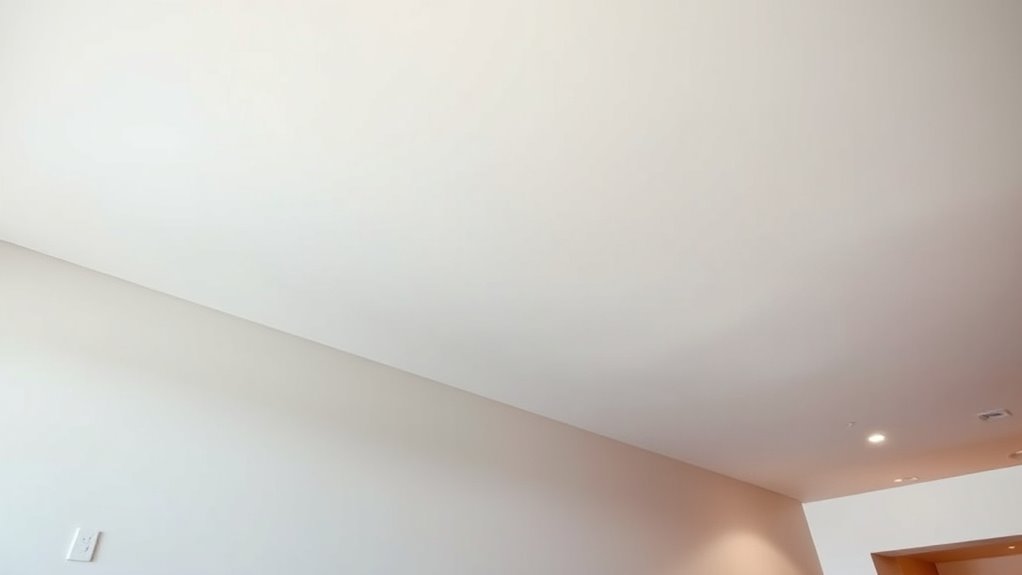To achieve seamless blends on big walls and ceilings, you need to master feathering edges by gradually tapering your paint at the borders with soft tools like brushes or sponges. Keep your brush lightly loaded, work slowly, and blend each section carefully, stepping back periodically to check your progress. Proper preparation and patience are key to hiding imperfections and creating a polished finish. Keep going to discover even more tips for flawless, professional results.
Key Takeaways
- Use soft brushes, sponges, or feathering tools to gently blend paint edges for seamless transitions.
- Gradually taper paint at the edges to create smooth gradients that merge with surrounding surfaces.
- Control paint application by lightly loading brushes and adjusting pressure to avoid harsh lines.
- Prepare surfaces thoroughly and practice on small areas to master blending techniques before large projects.
- Regularly step back to assess progress, ensuring even blends and a polished, cohesive finish across walls and ceilings.

Have you ever noticed how a photo’s edges can blend seamlessly into its background? That’s the magic of feathering, a technique that softens the shift between different areas of a wall or ceiling, creating a smooth, natural look. When you’re working on large walls or ceilings, especially with bold colors or intricate patterns, sharp lines can make the design look harsh or unprofessional. Feathering helps you achieve a more refined finish by gently blending the edges, giving your project a polished, cohesive appearance.
Applying feathering involves gradually tapering the paint or material at the edges so that it merges smoothly with the surrounding surface. Instead of creating a stark line where one color ends and another begins, you use a technique that disperses the paint’s pigment over a wider area, softening the boundary. This is particularly useful when you’re shifting between two shades or trying to hide imperfections. With the right tools—such as a soft brush, sponge, or specialized feathering tools—you can control the amount of paint that gets spread out, ensuring a gradual fade. Proper technique is essential for achieving a natural blend and avoiding uneven patches.
Feathering softens edges by dispersing paint over a wider area for a seamless blend.
Getting started with feathering on big walls or ceilings requires patience and a steady hand. First, you should prepare your surface thoroughly, cleaning and priming it to ensure even paint adhesion. When you’re ready to paint, load your brush lightly and start at the edge, applying the paint with gentle, sweeping motions. As you move away from the edge, gradually reduce pressure or paint amount. This creates a natural gradient, with the most paint at the edge and less as you extend further into the wall. If you’re using rollers or spray equipment, adjust the pressure or flow to achieve a similar effect. Practice on a scrap piece or a small section first to get a feel for how much paint to apply and how to control the fade.
In larger spaces, feathering can be especially effective in creating visual harmony. It allows you to blend multiple colors or textures without obvious lines or abrupt changes. It’s also a smart way to camouflage minor flaws or uneven surfaces. The key is to work slowly and methodically, taking your time to blend each section before moving on. Overworking the paint can cause uneven patches, so always step back periodically to assess your progress. Using high-quality tools and good technique, you’ll find that feathering transforms your big walls and ceilings into smooth, sophisticated surfaces that look professionally finished.
Frequently Asked Questions
What Tools Are Best for Feathering Large Surface Edges?
You should use a wide, high-quality paintbrush or a synthetic blending brush to feather large surface edges effectively. A large roller with a feathering edge can also help blend paint seamlessly. For best results, keep your tools well-loaded with paint and use smooth, sweeping motions. Using a paint sprayer can provide even coverage and smooth gradations , especially on big walls and ceilings, making your blending process quicker and more professional-looking.
How Long Does a Feathered Edge Blend Typically Last?
A feathered edge blend typically lasts for several years if you properly prepare, prime, and paint the surface. You should regularly inspect the area for any signs of wear or cracking and touch up as needed to maintain a flawless finish. Weather, wall conditions, and paint quality influence longevity, so taking careful, consistent steps guarantees your seamless blend stays stunning for a long-lasting, smooth, and shiny surface.
Can Feathering Techniques Be Used on Textured Surfaces?
Yes, you can use feathering techniques on textured surfaces, but it requires extra care. You need to choose the right tools, like a soft brush or roller, to blend the edges smoothly without disturbing the texture. Lightly feather the paint to avoid harsh lines, and work slowly to make sure the blend stays seamless. Keep in mind, textured surfaces may need multiple coats for a flawless finish.
What Are Common Mistakes to Avoid When Feathering Edges?
Did you know that improper feathering can lead to visible lines in 80% of painted walls? To avoid this, don’t over-apply paint, which can cause uneven edges. Keep your brush or roller moving steadily and blend outward gradually. Avoid pressing too hard or stopping suddenly, as these create marks. Also, don’t rush the process—patience guarantees smooth, seamless progressions, making your walls look professionally finished.
How Do Environmental Factors Affect Feathering on Big Walls?
Environmental factors like humidity, temperature, and airflow can substantially impact your feathering process on big walls. High humidity makes paint dry slower, causing uneven blends, while cold temperatures can hinder proper adhesion. Strong airflow from fans or vents can cause paint to dry too quickly, resulting in harsh edges. To achieve seamless blends, you should control these conditions by working in a stable environment, using fans cautiously, and maintaining consistent temperature and humidity levels.
Conclusion
Now that you know how to feather edges, you’re ready to transform your walls and ceilings into flawless canvases. Think of each seamless blend as a brushstroke in your masterpiece—your home’s perfect finish. Remember, patience and precision turn tricky borders into artful progressions. With your newfound skills, you’re not just painting; you’re creating a space that feels as smooth as a whisper. So go on, make those edges disappear like magic—your walls will thank you.










